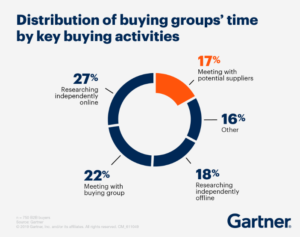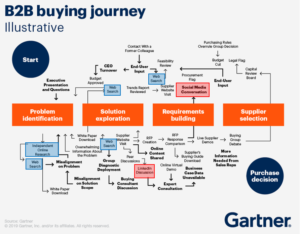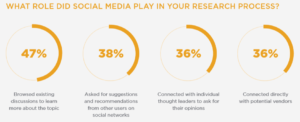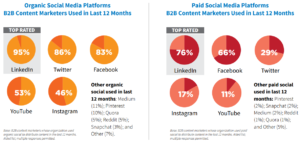Earlier this year, Gartner published an eye-opening report about the new B2B buying journey. The data revealed that buyers are increasingly turning to digital channels to gather information that influence their purchasing decisions. They’re doing this at the expense of face-to-face meetings with potential suppliers, allocating just 17% of their purchase consideration time to meeting with a sales rep. This percentage drops precipitously (to 5 or 6%) when a buyer is comparing multiple solutions.
This begs the question, how do B2B buyers distribute their time when considering a new tool or solution? The answer isn’t a straightforward one, particularly since there’s been a trend toward the creation of B2B buying groups which include as many as eight key decision makers in the buying process.
Distribution of B2B Buying Activities
The Gartner study found that buying groups spend most of their consideration time researching solutions independently online, with the next largest chunk of time spent meeting internally with the group.

Gartner found that many B2B marketers are struggling to connect with the new B2B buyer—not because sellers are struggling to sell, but because buyers are struggling to find easily accessible information prior to reaching out to a company’s sales team.
Per Gartner, “One of the things that we’ve come to understand and appreciate among all commercial leaders is just how hard it is to manage a commercial funnel in today’s complex landscape.”
Buying groups that are considering a complex solution often contain 6 to 10 decision makers who, on average, collect as many as six pieces of information each. This further complicates an already complex buying process.
While there are many factors and pieces of information that go into the purchase of a complex B2B solution, we’re going to focus on how B2B buyers interact with and use social media when considering a new solution and how marketers can reach this motivated group of digitally native (predominantly millennial) buyers.
How social media fits into the B2B buying journey
Millennials, born between 1981 and 2000, are the most prevalent generation in the workforce, comprising 25% of the total workforce as of February 2017, and on track to comprise 50% by 2020.
Millennials are the first generation that grew up in an age where cell phones, Wi-Fi, and internet access were ubiquitous. They are comfortable researching and purchasing items online for personal use, and this has inevitably influenced the way they approach the B2B buying journey. This chart by Gartner demonstrates what digital integration looks like in the modern B2B buying journey.

As you can see, the process of selecting a new solution is not a linear one and involves, among other things, many web searches (highlighted in blue) and at least two social media interactions (highlighted in red).
In the context of the B2B buying journey, social media is just another channel that’s baked into the online research phase. According to Demand Gen’s 2018 B2B Buyers Survey Report, B2B buyers are increasingly turning to review sites and third-party experts and peers on social media to help them evaluate technology solutions.
When asked what role social media plays in the research process, nearly 50% of survey respondents indicated that they browsed existing discussions to learn more about a topic, while 38% indicated they ask for questions and recommendations from other users on social networks.

How B2B marketers can leverage social media
It is tempting to measure the obvious when it comes to social media outreach and marketing—likes, reactions, shares, and comments all fall within the realm of measurable metrics. But the value of a like is questionable compared to real social interaction.
Going beyond likes involves developing a comprehensive social media strategy which focuses on multiple social media touchpoints—LinkedIn, Twitter, YouTube, Facebook. Well, you get the picture.
Here are a few things to consider when creating your social media outreach strategy.
- Be active on all major social networks: According to the Content Marketing Institute’s (CMI) 2020 Content Marketing Report, nearly all B2B marketers use LinkedIn for organic content marketing. It’s also the top paid social platform among B2B marketers. But it isn’t the only social platform that should be considered—and incorporated—into your outreach strategy.
The other widely used platforms for both organic and paid social marketing were Twitter, Facebook, YouTube, and Instagram. The CMI report lists each platform based on what platform showed the best results for both paid and organic social media marketing, as shown below.

- Answer questions on social media: One of the main ways that B2B buyers use social media is by soliciting advice and reviews from their peers. They also tend to read conversation threads on various platforms which help them discover and evaluate new technology.
With this in mind, it’s important for organizations to maintain an active social media presence on the top social channels used by buyers. Keep your business pages and profiles up to date. Make sure you answer questions quickly. Participate in conversations about your product or services to ensure that buyers have the most accurate information available, but can also see that you’re responsive.
- Create social-media specific content: The top performers in the CMI’s 2020 survey focused on optimizing content for their target audiences and personas. They prioritized content development by creating a centralized content marketing group within their organization. They built loyalty with customers and prospects by nurturing leads and subscribers and prioritizing their target audience’s informational needs over their organization’s sales and promotional messaging.
How does this relate to social media? High-quality, personalized content is highly shareable and is the absolute best way to leverage the ability of social media to amplify your content.
- Run social media ads: According to the Content Marketing Institute’s (CMI) 2020 Content Marketing Report, paid social is the top paid channel B2B marketers use as part of their content marketing strategy.
The top paid channels are, overwhelmingly, LinkedIn and Facebook, with Twitter, Instagram and YouTube also factoring into the overall paid social landscape for B2B buyers. Social ads can help amplify content by enabling you to boost organic posts, but they can also be a powerful way to get relevant buyers into the buying pipeline. Over 80% of B2B marketers in the CMI study use paid social to distribute their content—it was the top paid channel used for the purpose of amplifying content because it generates the best results.
Make sure to measure your success
As mentioned above, likes and interactions within social media can be very superficial in terms of what impact social outreach has to your bottom line. Companies must go beyond likes to fully understand how social channels generate qualified leads and sales. The CMI study found that 80% of B2B marketers use metrics to measure content performance, but only 65% have established KPIs, and only 43% measure content marketing ROI.
Establish your KPIs before you start a new social media initiative. Measure your success by determining the ROI of each tactic. This information is critical for understanding what works and what doesn’t and can help you shape your social media marketing strategy for the coming year.
Success with social media marketing is inextricably linked to developing high quality, relevant content that is easily accessible across the top social channels and platforms. The final word on how social media can effectively reach B2B buyers is: content, content, content. A comprehensive social media strategy should consider not just how to amplify content, but what content works best on what platform and for what persona.
